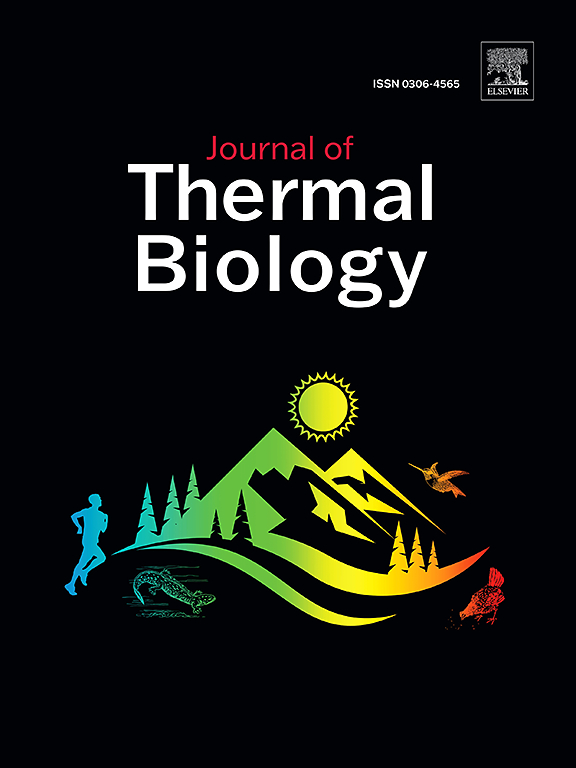在模拟热处理和热中性条件下影响公牛阴囊温度的因素,由多模式推断确定。
IF 2.9
2区 生物学
Q2 BIOLOGY
引用次数: 0
摘要
任何模型的创建都是复杂的,需要大量的数据,通常是通过一系列实验收集的。具体来说,温度湿度指数(THI)和热负荷指数(HLI)被用作在炎热气候条件下实施缓解策略的管理工具。睾丸暴露在炎热的气候条件下对公牛和其他物种的精子发生有负面影响。尽管公牛具有有效的阴囊温度调节能力,但当公牛处于热应激状态时,这些机制可能会崩溃,导致阴囊温度升高。了解气候条件对阴囊温度影响的能力对生产者来说可能是一个有价值的工具。在气候控制的房间里,六头和牛被暴露在一系列的热处理中,急性和慢性,中间有热中性期。通过手术植入的数据记录仪连续记录腹部和阴囊温度。监测同期的环境温度(AT)和相对湿度(RH)。采用信息论方法对数据进行分析。数据被分成三组,一组针对急性、慢性和热中性的环境条件。使用广义加性模型构建了每个组的全局模型,并包含了所有感兴趣的参数;腹部温度,AT, RH和THI。由这些全局模型子集组成的其他候选模型针对每种急性、慢性和热中性模型运行。对各模型进行了统计比较,并采用多模型推理来确定这些参数对阴囊温度的影响。急性的最佳模型包括腹部温度、RH和一个自回归因子(AR(1)),而慢性和热中性的最佳模型只包括腹部温度和AR(1)。在急性和慢性处理中增加腹腔温度可以提高模型强度,腹腔温度升高,阴囊温度升高。相比之下,在热中性模型中增加腹部温度并没有持续提高它们的强度。尽管样本量很小,但数据表明阴囊温度是可以模拟的。在这些模型中增加未来的观测将继续加强模型,提高它们的可用性。本文章由计算机程序翻译,如有差异,请以英文原文为准。
Factors influencing scrotal temperature in the bull during simulated heat treatments and thermoneutral conditions as determined by multimodel inferencing
The creation of any model is complex requiring vast amounts of data, typically gathered over a series of experiments. Specifically the temperature humidity index (THI) and heat load index (HLI) are used as management tools to implement mitigation strategies during hot climatic conditions. Exposure of the testes to hot climatic conditions has a negative impact on spermatogenesis in the bull, and other species. Despite the bull having effective scrotal thermoregulatory ability, these mechanisms can breakdown when the bull is under heat stressed causing scrotal temperature to increase. The ability to understand the effect climatic conditions have on scrotal temperature could be a valuable tool for producers. Six Wagyu bulls were exposed to series of heat treatments, acute and chronic with thermoneutral periods in between, in climate controlled rooms. Abdominal and scrotal temperature were continuously recorded via surgically implanted data loggers. Ambient temperature (AT) and relative humidity (RH) throughout the same periods were monitored. An information theoretic approach was used to analyse the data. Data were split into three groups, one for each of the ambient conditions of acute, chronic and thermoneutral. A global model for each of these groups was constructed using generalised additive models and included all parameters of interest; abdominal temperature, AT, RH and THI. Additional candidate models consisting of subsets of these global models were run for each acute, chronic and thermoneutral. Models were statistically compared and multimodel inferencing used to determine the effect these parameters had on scrotal temperature. The best model for acute included abdominal temperature, RH and an autoregressive factor (AR(1)) whilst the best model for both chronic and thermoneutral included just abdominal temperature and AR(1). Adding abdominal temperature to the model for the acute and chronic treatments improved the model strength with an increase in abdominal temperature increasing scrotal temperature. In contrast, the addition of abdominal temperature to the thermoneutral models did not consistently improve their strength. Despite a small sample size, the data indicates that scrotal temperature can be modelled. The addition of future observations to these models will continue to strengthen models, improving their usability.
求助全文
通过发布文献求助,成功后即可免费获取论文全文。
去求助
来源期刊

Journal of thermal biology
生物-动物学
CiteScore
5.30
自引率
7.40%
发文量
196
审稿时长
14.5 weeks
期刊介绍:
The Journal of Thermal Biology publishes articles that advance our knowledge on the ways and mechanisms through which temperature affects man and animals. This includes studies of their responses to these effects and on the ecological consequences. Directly relevant to this theme are:
• The mechanisms of thermal limitation, heat and cold injury, and the resistance of organisms to extremes of temperature
• The mechanisms involved in acclimation, acclimatization and evolutionary adaptation to temperature
• Mechanisms underlying the patterns of hibernation, torpor, dormancy, aestivation and diapause
• Effects of temperature on reproduction and development, growth, ageing and life-span
• Studies on modelling heat transfer between organisms and their environment
• The contributions of temperature to effects of climate change on animal species and man
• Studies of conservation biology and physiology related to temperature
• Behavioural and physiological regulation of body temperature including its pathophysiology and fever
• Medical applications of hypo- and hyperthermia
Article types:
• Original articles
• Review articles
 求助内容:
求助内容: 应助结果提醒方式:
应助结果提醒方式:


